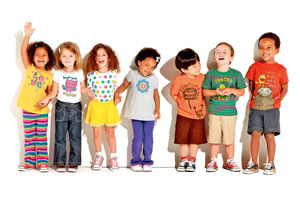
Harmful substances in childrens clothing
In its study "A little story about the monsters in your closet" published in mid-January, the environmental organisation?Greenpeace?criticised numerous discoveries of harmful substances in childrens clothing from renowned brand manufacturers.
In its study "A little story about the monsters in your closet" published in mid-January, the environmental organisation?Greenpeace?criticised numerous discoveries of harmful substances in childrens clothing from renowned brand manufacturers. In connection with this, the OEKO-TEX® Association expressly states that childrens clothing that meets the strict requirements of OEKO-TEX® Standard 100 does not pose any health risks for consumers.
For all the parameters (nonylphenol ethoxylates, carcinogenic arylamines, phthalates/softeners, organotin compounds, perfluorinated compounds (PFCs) and antimony) included by Greenpeace in the tested samples, the OEKO-TEX® Standard 100 requires compliance with strict requirements. The annually updated test criteria and limit values in many cases go far beyond the valid national and international requirements. From a consumer point of view, over 20 years of experience as a leading certification system for independent testing for harmful substances contributes to the highest degree of product safety. Extensive product checks after the certificate has been issued, as well as regular company audits, also ensure that the industry has a globally sustainable awareness of the responsible use of chemicals.
For the sake of objective consumer information, it should also be mentioned in connection with the Greenpeace report that some of the criticised chemicals are in no way limited to a use in textiles, and can also be found in products in everyday use. Perfluorinated substances (PFCs), for example, can be found in Teflon coatings for various kitchen utensils (e.g. frying pans) or are approved for functional food packaging, where they are subject to far more drastic and sensitive conditions of use than textiles. Surgical clothing can also be finished with PFCs for barrier protection. Antimony is a component of practically all textile articles made of polyester materials and occurs in most PET beverage bottles and other plastic packaging.
With its criteria for hazardous substance testing for textiles (OEKO-TEX® Standard 100) – as well as the additionally offered certification of environmentally friendly and socially responsible production facilities (STeP by OEKO-TEX®), the holistic approach of which also explicitly includes responsible chemicals management and sustainable manufacturing technologies – OEKO-TEX® specifically helps all companies and retail chains in the textile industry to optimise their production chains with regard to harmful chemicals in line with the "Zero Discharge of Hazardous Chemicals" (ZDHC) and detox campaigns respectively. In addition, in the store, end consumers are provided with a useful aid to decision-making when buying textile products of all kinds thanks to the label "Confidence in Textiles – tested for harmful substances in accordance with OEKO-TEX® Standard 100".



